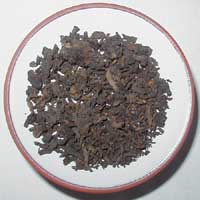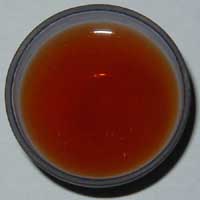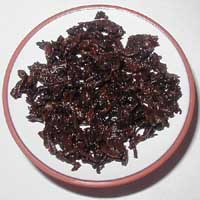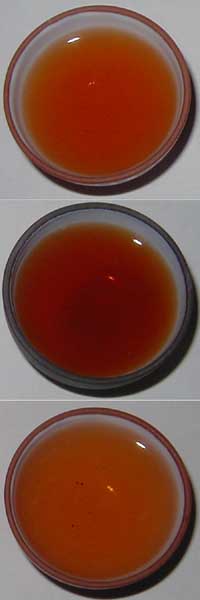 I had an interesting experience a couple of weeks ago that I’m only now getting a chance to write about. I should start out by saying that what I like about tea is strongly weighted in favor of factual information. That’s not to say I don’t like drinking it or whatever, but I don’t have a super-fantastic palate and I read other tea blogs that are of the “tasting journal” variety more to glean data than to try to figure out what particular nuances their authors are finding in a particular tea. I should also say that I’m more of a wulong kinda guy than a puer lover. Puer is very interesting and I enjoy drinking it, but it doesn’t make me light up like a new kind of wulong that I’ve never heard of before.
I had an interesting experience a couple of weeks ago that I’m only now getting a chance to write about. I should start out by saying that what I like about tea is strongly weighted in favor of factual information. That’s not to say I don’t like drinking it or whatever, but I don’t have a super-fantastic palate and I read other tea blogs that are of the “tasting journal” variety more to glean data than to try to figure out what particular nuances their authors are finding in a particular tea. I should also say that I’m more of a wulong kinda guy than a puer lover. Puer is very interesting and I enjoy drinking it, but it doesn’t make me light up like a new kind of wulong that I’ve never heard of before.
 That said, I’d often heard (and occasionally repeated) that if you taste a cooked (or “shu”) puer next to a naturally aged green (or “sheng”) puer, the natural aging process would win out over the “forced” aging process of the shu puer. Well, I finally buckled down and did the experiment. On two different occasions, I tasted an old green against a young cooked puer. The green was a Yinhao sheng puer tuocha (or for those puer beginners, a bunch of naturally aged and fermented tea leaves pressed into the shape of a bowl or bird’s nest) from the 1980s. It was also my first sheng puer of that age…most of my puer experience is of ones made in the last 10 years or so.
That said, I’d often heard (and occasionally repeated) that if you taste a cooked (or “shu”) puer next to a naturally aged green (or “sheng”) puer, the natural aging process would win out over the “forced” aging process of the shu puer. Well, I finally buckled down and did the experiment. On two different occasions, I tasted an old green against a young cooked puer. The green was a Yinhao sheng puer tuocha (or for those puer beginners, a bunch of naturally aged and fermented tea leaves pressed into the shape of a bowl or bird’s nest) from the 1980s. It was also my first sheng puer of that age…most of my puer experience is of ones made in the last 10 years or so.
 The first cooked was a Menghai Tea Factory bing from December 2005, and the other bing was one that I don’t have any information on but was a similar kind of decent-quality cooked puer.
The first cooked was a Menghai Tea Factory bing from December 2005, and the other bing was one that I don’t have any information on but was a similar kind of decent-quality cooked puer.
And my experience was that the cooked puers had a “bigger” flavor, and that the flavor seemed somehow “damp.” Puer is going to be earthy no matter how you cut it, but the shu/cooked ones tend towards the fall leaves / fresh soil / basement kinds of flavors.
 The Yinhao, though, was certainly of a different breed. My first and strongest image was that of being several floors above the basement, in some kind of old manor-house library or historical archive. It was a dry-earthy flavor…delicate, like old books, but also with little hints of things to discover by flipping through the (if you’ll forgive me for mixing metaphors with a single word) leaves.
The Yinhao, though, was certainly of a different breed. My first and strongest image was that of being several floors above the basement, in some kind of old manor-house library or historical archive. It was a dry-earthy flavor…delicate, like old books, but also with little hints of things to discover by flipping through the (if you’ll forgive me for mixing metaphors with a single word) leaves.
The side-by-side comparison with the unknown cooked puer happened to be at an introductory puer class. The general consensus amongst the puer beginners was that they liked the cooked one better than the aged green. My guess is that it was that the stronger, more basic flavor of the cooked tea was easier to “get” whereas the aged green was something you’d not pick up on unless you had some more puer experience under your belt.
Or, it could just be that cooked puer tastes better to most folks and it’s that us tea geeks think the aged greens are supposed to be better so our minds play tricks with our experience. Who knows…but if you get a chance to repeat my experience, I encourage you to take it, and to let me know about what you noticed.
P.S. — I got 14 or 15 brews out of the Yinhao, whereas I didn’t get nearly as many of the other two. So the aged green had more staying power than the two particular samples of cooked that I used. The picture to the right shows steepings #1 at 30 seconds, #3 at 50 seconds, and #6 at a minute and a half. And yes, it really did get darker and then lighter again.
